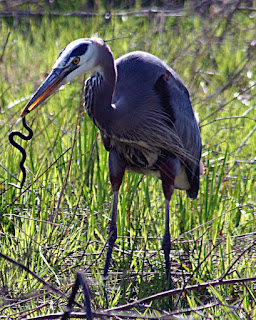When I started to check out a bluebird box last week I was greeted by a red wasp which nailed me in the abdomen through my T-shirt. I got my revenge on the wasps with
pyrethrin spray*(see below). I cleaned out the wasp bodies, and removed the nest to study the babies.

These were red paper wasps,
Polistes carolina, a species that that commonly builds nests in bird houses as well as under eaves and other concealed places around our houses. They form their nests using wood fibers which they chew and mix with saliva to create hexagonal cells for their young. The larvae are protected by the adults in a complex society described in
Wikipedia.
 |
| Larvae in cells |
|
|
|
The nest is attached by a thin but tough pedicle and cells are arranged to orient the growing larvae head-down towards the ground. "Paper wasps secrete a chemical which repels ants, which they spread around the base of the anchor to prevent the loss of eggs or brood." (
Paper wasps). As they grow the larvae will pupate, spinning a cocoon of silk which caps the chamber.
 |
| Larvae inside pupal cells |
In this video I first exposed the nest to sunlight. Since they are normally hanging upside down in a dark place, the larvae of different ages began to move randomly, trying to figure out what was going on. I then opened a few sealed chambers, exposing larvae that hadn't had a chance to complete pupation. They wiggled aimlessly and were incapable of purposeful movement like many other species' larvae.
While nursing the sting I had to remind myself that paper wasps have a beneficial role in the nature. They are are important in controlling populations of other species that we consider pests such as hornworms and tent caterpillars.
They also feed on other insects such as the larvae of beetles, flies and moths. They also feed on
nectar and thus serve as pollinators.
========
*
Pyrethrum Spray - Several sources such as
Sialis.org recommended pyrethrum as a safe way to remove wasps from a birdhouse. Pyrethrins are gradually replacing organophosphates and organochlorides
as pesticides of choice, since these other compounds have been
shown to have significant and persistent toxic effects to humans.
"Pyrethrum is a powerful, rapidly acting insecticide originally derived from the crushed dried flowers of the daisy Chrysanthemum cinerariifolium.
Permethrin is a manmade synthetic pyrethroid. It does not repel
insects, but instead works as a contact insecticide, causing nervous
system toxicity, leading to death, or ‘knockdown’, of the insect. The
chemical is effective against mosquitoes, flies, ticks, fleas, lice, and
chiggers. Permethrin has low mammalian toxicity, is poorly absorbed by
the skin, and is rapidly metabolized by skin and blood esterases." Travel Medicine 2013
There is a lot of research on
Polistes species learning and memory, behavior, facial recognition, and even personality
at this link.
Colorado State University Extension has extensive information on the European paper wasps now found throughout the US. The life cycle is similar to our native
Polistes species as described here.
"Nests are constructed of paper, produced from chewed wood fibers of
weathered fences, porch decks and similar sites. Initially, a few
hexagonal paper cells are formed and eggs laid in the cells. Upon hatch,
the wasp larvae are fed crushed insects, usually caterpillars, that the
overwintered queen discovers in foraging trips among nearby plants.
According to bugguide.net, “The wasp then malaxates, or softens the food and in doing so absorbs most of the liquid in the food. This solid portion is given to older larvae and the liquid is regurgitated to be fed to younger larvae.”
When full grown the larvae then seal over the cell and pupate.
Development of the wasps to the adult form is usually completed in 3 to 4
weeks after eggs are laid. The new wasps assist in colony activities of
nest construction, foraging, and caring for young. The original queen
increasingly remains restricted to the nest as new workers take over
colony activities.
The colony continues to grow through the summer and may contain
several dozen individuals by the end of summer. The nest is continuously
expanded and reconstructed through the summer and may contain a hundred
or more cells by fall. A few of the wasps produced later in summer are
males and increasing numbers of the females become sexually mature at
that same time. Mating occurs and the mated females are the surviving
overwintering stage. Males and non-reproductive females do not survive
winter and the nest is abandoned by late fall."
=========
Wasps like their honey






























